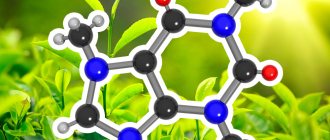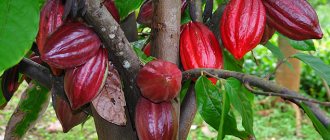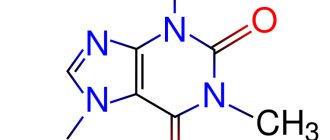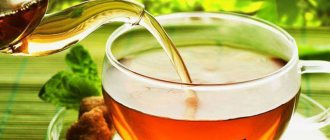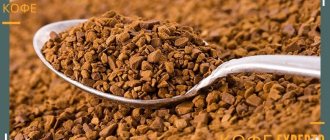Green tea is a popular drink in many countries around the world, originally from China and is a type of tea, the production technology of which differs from other types of teas. There are several varieties of green tea; they vary depending on harvest time, growing conditions and a number of other factors. Often, when talking about green tea, we mention its positive effects on our health. However, its benefits have not been scientifically proven, so the health benefits are only mentioned in anecdotal publications. Green tea contains caffeine, although in much lower quantities than other caffeinated drinks.
Peculiarities
A cup of espresso or cappuccino works almost instantly. The nervous system reacts after 2-3 minutes by accelerating the heart rate. The mood rises, brain activity is activated, and the desire to do something arises. Coffee effectively awakens you and improves your performance, but the result quickly wears off and you return to your original state.
The “tea” effect is different from the “coffee” effect. It is soft and unnoticeable, lasts several hours and goes away as smoothly as it appears. Tea does not contain pure caffeine, but is associated with tannin. They form theine, due to which the action is more delicate, there are no pressure surges and sudden changes in heart rate. It dilates blood vessels, improves the functioning of the nervous system and brain. Its advantages are that it:
- does not accumulate in the body;
- the dry leaf contains it in greater concentration than the infusion;
- is slowly absorbed into the blood and quickly excreted;
- gently stimulates the heart and central nervous system.
It is impossible to say unequivocally which type of tea will have more tonic substances - the different biochemical composition makes such a comparison simply impossible. According to the data, the amount of the energizing substance ranges from 30 to 100 mg per serving. You can estimate this value relative to other drinks in the table below.
| Name | mg caffeine per cup |
| Green tea | 30-100 |
| Ground coffee | 110-200 |
| Instant coffee | 60-173 |
| Espresso | 240-720 |
| Cappuccino | 2 |
| Black tea | 40-100 |
| Energetik | 70-80 |
Coffee or tea: which has higher caffeine content?
It is not so easy to figure out whether tea or coffee contains more caffeine. The concentration of the alkaloid in the drink is influenced by a combination of factors, including the variety and type of product (both tea and coffee), the method of preparation, and the amount taken for brewing.
Instant coffee contains less alkaloid than natural coffee from ground beans. High-quality, strongly brewed black tea will not be inferior to such coffee in terms of caffeine content. If you brew natural weak coffee and add cream or milk, the alkaloid content in the composition decreases.
Caffeine content in different types of coffee (mg per 170 ml cup)
Serving size also affects whether tea or coffee contains more caffeine. A serving of Espresso coffee does not exceed 50 ml, while a mug of tea usually holds 200 - 250 ml. The proportion of caffeine increases as a result of prolonged infusion.
The origin of the raw materials, the type of processing, and the brewing method determine which of the two drinks will contain the most caffeine.
The alkaloid is found not only in tea and coffee products. A substance with an invigorating effect is included in chocolate products, sweet carbonated drinks, and is also included in energy mixtures.
The energetics combine compounds that stimulate the nervous system. Carbon dioxide promotes the rapid development of the effect. For comparison, the caffeine content in a can of energy drink is 80 – 150 mg, which exceeds the amount in a serving of strong coffee. Regular consumption of such mixtures leads to the development of hypertension, diabetes, and exhaustion of the nervous system. The effect of such compositions is not comparable to the mild effect of a good tea infusion or coffee.
Energy drink consumption, especially systematically, can have a negative impact on health. It is not recommended to drink synthetic compounds with caffeine together with alcohol. To achieve a tonic effect, it is better to give preference to natural products and follow the recommended safe doses.
A comparative table that shows how much of the substance various types of popular drinks contain will help you figure out which drink has the most caffeine. For comparison, data are given for formulations prepared according to the classic recipe in accordance with the recommended dosages and preparation regimen.
Table 2. Comparative table of caffeine content in drinks
| Name | Amount of caffeine (mg/100ml) |
| Natural black coffee | 40 – 70 |
| Instant coffee | 30 – 50 |
| Black tea | 40 – 60 |
| Green tea | 20 – 30 |
| Decaffeinated coffee | 3 – 5 |
| Decaffeinated tea drinks | 2 – 3 |
| Hot chocolate | 5 – 10 |
| Sweet carbonated caffeinated drinks | 5 – 10 |
| Energy | 20 – 35 |
Decaffeination significantly reduces the amount of caffeine, but does not allow you to get rid of the substance completely. In the process of removing the alkaloid, chemical reagents are used, which deprives the composition of its naturalness.
Is there a lot of caffeine in green tea?
This stimulant is present in all types of dry raw materials, but in different concentrations. Moreover, its presence in the cup depends on both the method of preparation and the processing of the leaf.
The largest reserve (up to 5% of the total mass) is contained in young shoots. 200 ml of a drink made from this brew can contain from 60 to 85 milligrams of an invigorating substance.
The green variety is the leader in its invigorating effect. However, this does not mean that it contains more caffeine than coffee - this is a common misconception. It is only true for leaves, not for prepared drinks. The tea leaf actually contains more substance, but it is not transferred to the finished drink in full.
What determines the amount of caffeine?
This indicator is influenced by a variety of factors, ranging from growing conditions to methods of leaf processing. Since natural conditions also matter, teas from the same producer, harvested from the same plantation at different times, during the dry or rainy season, may contain different amounts of caffeine.
- Teas grown in the shade, such as Japanese Sencha and Matcha, contain more caffeine than those grown in the sun. The plant takes longer to ripen, and all the substances accumulate in it. By the way, leaves from high mountain plantations are more saturated with caffeine, since the air there is colder and the ripening process takes longer.
- Tea bags release more caffeine into the cup because the tea leaves are smaller and extraction occurs faster, as is the case with powdered teas. If you want a minimum dose, choose rolled leaves; they brew slowly and release all their components more slowly.
- Any teas with additives have a lower caffeine content than pure varieties. Because the same number of leaves is used for brewing, but there is less tea itself. Flavorings also reduce concentration.
- Caffeine is concentrated in the buds and leaves, and less in the stems and branches. There are drinks that are made from young branches rich in antioxidants, for example, Japanese Kokeicha and Hojicha.
- The younger the leaves, the greater the concentration of various substances in them. For example, Sencha, which is harvested in the spring, is richer than the late-harvested Bancha.
- The longer you steep the tea, and the hotter the water, the more caffeine will transfer into the cup. Therefore, it is recommended to use slightly cooled water (1-2 minutes after boiling), and not to keep the leaves longer than the manufacturer’s instructions on the package.
Benefits and harms
Regardless of how much caffeine green tea contains, this substance has a number of standard physiological effects on the body:
- releases energy by burning fat;
- stimulates the production of adrenaline;
- increases blood pressure;
- excites and invigorates.
pros
Scientists believe that moderate consumption of caffeine-containing products is beneficial for:
- Prevention of Alzheimer's disease and dementia.
- Memory improvements.
- Stopping the process of destruction of brain cells.
- Reducing the risk of cancer and inflammatory processes in the cardiovascular system.
Minuses
Systematic abuse of such drinks causes a risk of exhaustion of the nervous system, depression of mental activity and physical activity. It can lead to nervousness and insomnia, and increase stress and anxiety. The risk increases due to the cumulative effect of the alkaloid, which remains in the blood for up to 9 hours.
What is caffeine and what does it do?
Caffeine is a naturally occurring chemical found in the leaves and fruits of more than 60 plants, including the leaves of tea plants ().
It is a central nervous system stimulant that is consumed worldwide to increase energy levels and combat fatigue and drowsiness. It blocks the effects of a neurotransmitter called adenosine, which builds up throughout the day and makes you feel tired ().
Caffeine consumption is also associated with a number of health benefits, such as improved mood and brain function, increased metabolism, and improved physical activity (, , ).
However, some people may be more sensitive to the effects of caffeine than others (, ).
Additionally, people who consume too much caffeine may experience anxiety, insomnia, or irregular heartbeat ().
Summary:
Caffeine is a natural stimulant that can help you stay alert. Its consumption may also have some beneficial effects on the body, such as improved brain function.
How much does it contain?
Most varieties have a tonic effect. All of them contain theine in varying amounts. The exception is herbal, flower and berry species. Their tonic effect is not associated with caffeine influence.
The amount of caffeine in green tea depends on the raw material: young buds and leaves are especially rich in it, and in mature leaves its concentration decreases from 5 to 1.5% of the total mass. In terms of one cup, this is 60-80 mg.
Depending on the place of growth, the chemical composition of the tea leaves also changes. On high mountain plantations the air is colder, the plant grows more slowly and accumulates the alkaloid.
Which tea has no caffeine?
All traditional teas contain caffeine. If you need to choose a drink without an alkaloid in its composition, you should pay attention to herbal and fruit analogues.
- Blooming Sally. A drink based on angustifolia fireweed is absolutely safe. It does not affect blood pressure, but perfectly invigorates and tones.
- Hibiscus. Sweet and sour tea made from hibiscus petals is rich in polysaccharides, amino acids, vitamins, but does not contain theine.
- Rooibos. Herbal tea made from the shoots and leaves of Aspalatus lineara is valued for its natural sweet taste and health benefits.
- Herbal infusions. Without fear for your well-being, you can drink decoctions of chamomile, sage, lemon balm and other plants at any time of the day. They strengthen the immune system and calm stress.
- Fruit or berry infusions. To quench thirst and enrich with vitamins, drinks based on rose hips, apples, and raspberries are good.
How is caffeine removed from tea?
Some companies produce an unusual product - black or green tea without caffeine. Manufacturers assure that such a drink is safe, since the negative effects of the alkaloid on the body when consumed are excluded.
To produce caffeine-free tea, the tea leaves undergo an additional processing step. It is exposed to organic solvents. Such compounds can be ethyl acetate or methylene chloride. The first substance accumulates in the leaves and gives them bitterness, the second is considered less toxic, but despite this, it is prohibited in a number of countries.
The decaffeination process can be started by treating with carbon dioxide. In high concentrations, carbon dioxide can act as a non-toxic solvent, neutralizing caffeine molecules in tea leaves. The method is safe, but expensive, so the price of tea leaves processed in this way increases significantly.
None of the modern decaffeination methods can completely remove the alkaloid from the leaves. Its concentration only decreases to minimal values - 5-10 mg per cup.
Which to choose
When choosing, experts recommend paying attention to several parameters that will help determine the concentration of theine:
- Composition of raw materials. The large leaf is inferior in number to the young leaves and buds.
- Processing method. In weakly fermented classes, its concentration is higher; prolonged fermentation leads to a decrease in the caffeine content in the total mass.
- Collection time. For lovers of tonic properties, spring assemblies are suitable.
- Climate, plantation location. Whether green tea contains more caffeine can be determined by knowing where it grew. In the mountains, the plant develops more slowly due to lower temperatures, so it accumulates it.
Effect of caffeine
Positive properties of this alkaloid:
- Charges the body with vigor.
- Promotes the removal of fats.
- Fights hangover syndrome.
- Prevents intoxication of the body.
- Has diuretic properties.
- Normalizes blood pressure and blood circulation.
Green tea extract contains quite a lot of caffeine, which is why it is used in the production of cosmetics. It is able to tone and rejuvenate the skin.
A large number of people ask themselves the question: “Does green tea have caffeine and how can drinking tea affect your health?” Experts say that for a person who does not have health problems, caffeine does not pose any danger if you drink it in small quantities.
They call twelve cups of tea per day an acceptable maximum dose.
How to reduce concentration
The effect of tea on the body is both significant and delicate. Its pleasant taste and aroma are difficult to refuse. But in nature there is no green tea without theine, and it can have a negative effect on tea ceremony lovers.
7 Tips to Reduce Theine Content
- When choosing a tea leaves, first find out its composition. The elite product consists of the first two leaves and buds; its caffeine reserve is the largest. Varieties that are specially shaded before harvest are not suitable. These include, for example, Matcha. The tea leaves made from the branches of the tea bush, on the contrary, have almost no tonic effect.
- Listen to yourself to know how you feel about it. Scientists recommend not exceeding a daily dose of 300 mg.
- Drink infusions that initially contain a small percentage of stimulants. For example, in the Bunch class, especially late harvest, the caffeine supply is 0.015% per serving, and in black varieties it is about 0.05%.
- Avoid bagged and powdered formulas.
- Drain the first brew. 80% of the alkaloid is released within 45 seconds.
- Consider gentler drink options, such as hibiscus or camellia.
- Do not steep tea for more than a minute. By increasing the infusion time to 5, you will increase the dose by 4 times.
How to recharge your energy for the whole day?
If you wake up in a bad mood, there is a proven way to switch to a positive wave. Our option is Curtis tea and a few minutes alone.
If you need a quick pick-me-up, brew black Ceylon tea from Curtis. Not only caffeine, but also the aroma of juicy citruses will get you out of bed! The second option is a cup of green tea with pineapple pieces and tropical mango flavor.
This is a time just for you: drink tea with your favorite treat, imagine what your ideal day should be like. And make today just like that! The anticipation of wonderful events will charge you even more, and all peaks will be conquered by you.
How to brew and drink correctly
Traditional cooking vessels in China are the gaiwan and the Yixing clay teapot. Fans of tea ceremonies also use flasks, thermoses, and French presses. The main thing in the procedure is compliance with the following rules:
- the dishes should be small: from 100 to 300 ml;
- it needs to be rinsed with boiling water to warm the walls;
- the dry sheet is placed and shaken a little so that it is distributed over the walls;
- the first brew is immediately drained, its functions are to warm up and wash away dusty deposits;
- green teas and oolongs can be brewed repeatedly - the pouring method - by pouring the raw materials several times, with each new brew you get a healthy and tasty infusion with a slightly different taste.
The tea leaves poured for the first time release a large portion of caffeine into the water; each subsequent serving will contain less of it. But if the water temperature is less than 70 degrees, the alkaloid will pass into the decoction slowly - this is due to its ability to dissolve well in a hot environment.
Polyphenols and catechins soften the effect of theine more effectively if you drink the infusion hot.
Effect of tea brewing method on caffeine content
The brewing method also plays a role. The more leaves are used, the stronger and richer the infusion is. The concentration of the alkaloid in it will be higher. In addition, with each new spill, the amount of caffeine decreases, so large-leaf varieties can be safely refilled with water. This approach will only improve the quality of the drink and make it safer.
Temperature
The caffeine dose increases when using too hot water. Steep boiling water helps release theine. Useful substances, on the contrary, can be destroyed. The optimal temperature for each variety is different, but it should not exceed 85-90 degrees.
What else do you need to know
Moderation and common sense will help you find a balance between the benefits and risks of drinking invigorating drinks:
- absorption of the substance largely depends on individual tolerance and metabolic characteristics;
- there is no direct connection between tannin consumption and increased blood pressure; this indicator is conditional and depends on the sensitivity and characteristics and concentration of the infusion;
- increased consumption of caffeine-containing products after 50 years can provoke calcium leaching;
- the diuretic effect is not associated with dehydration;
- the ability to sober up and get out of a state of alcoholic intoxication is nothing more than a myth, since it can cause harm to a drunk person by increasing the load on the cardiovascular system;
- men are less sensitive to it than women, and with age the reaction to alkaloids becomes stronger.
How caffeine affects our body
Firstly, when it enters the bloodstream, it blocks the production and action of adenosine, imitating this hormone. Adenosine causes drowsiness and slows down the functioning of centrifugal neurons, so blocking it promotes activity.
That is why a person feels collected, increased attentiveness and vigor. The feeling of fatigue goes away, your mood and business activity improve.
Secondly, the production of adrenaline is activated, which leads to an increase in heart rate, and in most cases, blood pressure. Blood flow increases and an increased dose of glucose reaches the muscles. The reaction speeds up, movements become faster and sharper. This effect is used in training, temporarily increasing the potential of athletes.
Thirdly, the level of the neurotransmitter dopamine, which is also called the “happiness molecule,” increases in the brain. It is involved in the process of signal transmission between nerve cells. Besides:
- associated with it is a feeling of comfort and pleasure, harmony and joy;
- stimulates the digestive system, increasing the secretion of gastric juice;
- speeds up metabolism, breaks down fats, helps to lose weight;
- reduces the risk of cancer.
A dose of 10 to 20 grams (depending on individual sensitivity) is considered lethal. It is very conditional, because to get it you need to drink at least 100 cups of green tea or coffee.
Determination of the content of some biologically active substances in various types of tea
The article presents the results of a study of some varieties of black and green tea for the content of biologically active substances (BAS) such as vitamin P (rutin), catechins, caffeine, tannin. It has been experimentally confirmed that the largest amount of biologically active substances is present in green tea varieties.
Key words:
biologically active substances (BAS), vitamin P, catechins, caffeine, tannin, tea varieties.
Abstract.
The article presents the research results of some varieties of black and green tea on the content of such biologically active substances (BAS), as vitamin P (rutin), catechins, caffeine, tannin.
Experimentally proven that the greatest quantity of substance present in green teas. Keywords:
biologically active substances (BAS), vitamin P , catechins, caffeine, tannin, tea.
Tea (Camelliasinensis =Theasinensis) is one of the most important gifts of nature. A tea drink is a complex combination of substances that has a multifaceted and generally beneficial effect on the human body. Tea has many properties, so it can be used in tea drinking, as a medicinal plant, and as an ornamental plant.
Tea is rich in biologically active substances (BAS). Modern science identifies the following groups of substances that give tea healing properties. These are tannins, essential oils, alkaloids, proteins, amino acids, vitamins, pigments [1].
Vitamins are invaluable substances for the body that are vital for humans in small quantities. One of the most important natural antioxidants is vitamin P (rutin), which, in addition, takes an active part in a number of biochemical processes (normalizes the condition of capillary walls, lowers blood pressure, slows the heart rate, participates in bile formation, facilitates and accelerates the course of allergic reactions, vitamin P can partially cover the body's need for vitamin C; it was given the additional name vitamin C2 or C-complex; vitamin deficiency leads to fragility and fragility of capillaries [1].
Catechins are unique natural antioxidants that have antibacterial properties, repel the “attack” of free radicals, prevent damage and destruction of cells, thereby slowing down the aging of the body and helping to prevent cancer.
Catechins have long been an object of keen interest for scientists around the world. It has now been experimentally confirmed that they have a number of properties. Thanks to the high biological activity of catechins, they regulate the permeability of capillaries and increase the elasticity of their walls, and also help the body more efficiently use ascorbic acid (vitamin C). Therefore, catechins are used in the treatment of diseases, associated with impaired capillary function, edema of vascular origin. One cup of green tea provides an average of 60 milligrams of catechins. Of course, the amount of these substances in tea depends on its variety.
Among the many advantages of tea, its remarkable mild psychostimulating effect is important. This is due to the caffeine content in tea. Caffeine is one of the derivatives of the purine base xanthine. Has tonic properties. In its pure form, it is colorless, odorless, and tastes bitter. Also found in coffee, cocoa, cola nuts and some other tropical plants. Caffeine (theine) in tea is combined with tannin, forming caffeine tanate, which acts more indirectly, more mildly (than coffee caffeine) on the cardiovascular and central nervous system, while significantly activating brain activity. Caffeine tanate is formed from caffeine and tannin during the processing of tea leaves. At the same time, bitterness disappears from it, it gives the tea characteristic properties (aroma, color) and causes clouding of strong tea when cooling (the formation of so-called “cream” is an indicator of high quality tea) [2]. Tea caffeine does not linger or accumulate in the human body, which eliminates the risk of caffeine poisoning even with frequent tea consumption [3].
Tea contains more than 30 polyphenols, which are traditionally called tannins or tannins.
Tannin is a light yellow or brownish-yellow amorphous powder with a weak, peculiar odor and an astringent taste. Easily soluble in water and alcohol. Aqueous solutions form precipitates with alkaloids, protein and gelatin solutions, and heavy metal salts. Used as an astringent and local anti-inflammatory agent. The astringent effect of tannin and other astringents is due to their ability to cause protein precipitation. When applied to mucous membranes or to a wound surface, they cause partial coagulation of mucus proteins and lead to the formation of a film that protects the sensitive nerve endings of the underlying tissues from irritation. At the same time, a decrease in pain, local vasoconstriction, limitation of secretion, as well as direct compaction of cell membranes help reduce the inflammatory response. Due to the fact that tannin forms insoluble compounds with salts of alkaloids and heavy metals, it is often used for poisoning with these substances (it is recommended to wash the stomach with a 0.5% aqueous solution of tannin). It is tannins that give tea its characteristic tart taste. On average, their content in tea leaves ranges from 8% to 30%, being the main component of all substances in the tea solution. They are a complex mixture of substances.
Currently, a huge assortment of tea is presented on the shelves of our stores. However, not all varieties have good quality and, accordingly, benefits, so biochemical research of different varieties of tea is very relevant.
The purpose of this study was to experimentally determine some biologically active substances in different types of tea.
Research methods: experimental (chemical experiment), mathematical (statistical processing of results).
Organization of the study. During the study, an experimental determination of the content of some biologically active substances in 9 different varieties (5 varieties of black and 4 varieties of green) tea was carried out. The experiment was carried out in at least three replicates. The qualitative determination of catechins was carried out using paper chromatography. It is based on the ability of catechins to react with a hydrochloric acid solution of vanillin, forming colored compounds. Depending on the content of catechins in different types of tea, pink, light red and red colors appear. During our experiment, the brightest coloring was in green tea varieties. Green tea varieties such as GreenteeGreenfield and GreenteeTess were especially notable for their red color.
Substances such as vitamin P (rutin), caffeine, tannin were determined quantitatively using generally accepted methods.
We have summarized quantitative data on the studied biologically active substances in a comparative table 1 and a histogram (Fig. 1.)
Table 1
Content of some biologically active substances in various types of tea
| № | Type of tea | Content routine(μmol\kg) | Tannin content (%) | Volume of caffeine released mm3 |
| 11. | Princess Nuri (black) | 150,7 | 2,7 | 20 |
| 22. | Akbar (black) | 168,3 | 6,91 | 19,2 |
| 33. | May (black) | 153,9 | 3,8 | 24 |
| 44. | Princess Gita (black) | 198,4 | 4,93 | 22 |
| 55. | Cheerfulness (black) | 154,8 | 3,85 | 21 |
| 66. | Golden bowl (green) | 207,1 | 7,28 | 25,4 |
| 77. | Green tee Greenfield (green) | 470,4 | 8,1 | 45,5 |
| 88. | Princess Java (green) | 361,8 | 5,02 | 21 |
| 99. | Greentee Tess (green) | 425,5 | 9,74 | 39,1 |
Rice. 1.Content of biologically active substances in some types of tea.
Types of tea: 1 – PintsessaNuri; 2 –Akbar; 3 – Maysky; 4 – Princess Gita; 5 – Cheerfulness; 6 – Golden Cup; 7 –GreenteeGreenfield; 8 – Princess Java; 9 –GreenteeTess.
Analysis of the results showed that the largest amount of biologically active substances is found in green tea varieties. The varieties GreenteeGreenfield and GreenteeTess have especially high rates. From the comparative table and histogram it can be seen that there is twice as much vitamin P (rutin) in green tea varieties as in black tea varieties. The Zolotaya Chasha variety turned out to be the weakest in terms of the amount of BAS from green teas. The biochemical indicators of different varieties of black tea are very close to each other (Table 1); only the Princess Gita variety stands out slightly in terms of the amount of vitamin P.
Knowledge about the characteristics of the content of biologically active substances, obtained during the study, can help in choosing a type of tea; you just need to remember that biologically active substances have high physiological activity at appropriate concentrations; most often, the recommended brewing dose is indicated on the packages. If these conditions are met, tea can be not just a tasty tonic drink, but also have a healing effect.
Literature:
1. Devyatnin V.A. Vitamins. – M.: Medicine, 1948. –293 p.
2. Tatarchenko I.I. Chemistry of subtropical and flavoring products: A textbook for students of higher educational institutions. – M.: Publishing House, 2003.–256 p.
3. Kharkevich D.A. Pharmacology. – M.: Medicine, 1987. – 560 p.
Standards for caffeine content and consumption
Disputes among experts regarding the measure of consumption of alkaloids have been going on for a long time. It is important to note that it is incorrect to calculate the permissible volume in cups, since serving sizes and strength levels vary from person to person.
For an adult, the one-time recommended dose is 100-200 mg. You can repeat it 2-3 times a day without fear of harming your health. Speaking about the optimal amount, scientists indicate no more than 300 mg. This is approximately 5 cups of unfermented or lightly fermented infusion.
For pregnant women, this figure is lower - about 200 mg; for children and adolescents it is calculated based on body weight - no more than 2.5 mg per kilogram.
Approximate caffeine content in different types of tea (per 100 ml)
Tea theine provides a noticeable physiological effect. It contains from 14 to 80 mg per 230 ml serving. Moreover, the same class has a different amount of it.
For example, pu-erh contains 1.5 to 5%. Moreover, the dependence has been established even on the size of the leaf: small ones highlight it more than large ones. The location of the plantation in the mountains leads to a greater presence of stimulating elements in the plant. But pressed raw materials are less rich in invigorating components than loose ones.
Proper brewing with water at a temperature of 90 degrees, and not with boiling water, allows you to reduce the undesirable effect of alkaloids, reducing their concentration in the drink.
In mate, the concentration of matein reaches 1.8%. Its action differs from other infusions, since it does not contain catechins and a large amount of chlorogenic acid.
The fermentation of oolongs is different, and therefore their composition is not uniform. However, most types are less rich in theine (about 25 mg per 100 ml) than other tea varieties.
You can purchase all the considered varieties in the Russian Tea Company online store. The catalog contains both weighted and packaged products.
The most caffeinated tea varieties
One of the most caffeinated tea varieties is oolong - per 230 ml it will contain 12-55 mg of alkaloids. The amount of this substance depends on the region in which the tea was grown - for example, tea from China will contain less caffeine than from India.
Red tea contains 30 mg of caffeine per 100 ml of drink - its properties are similar to black tea, but it tones more moderately.
Oolong contains 25 mg of caffeine per 100 ml of drink - it maintains strength well, improves mood and has an unusual taste.
Pu-erh (10 mg per 100 ml) - although it contains very little caffeine, it is a wonderful tonic. Also, it promotes good digestion of food, improves metabolism and the functioning of internal organs.
Decaf Green Tea: Fiction or Truth
There are two known ways to neutralize the effects of caffeine. The first is considered less harmful because it occurs without the use of chemicals. CO2 – extraction or “fizzing”, done using carbon dioxide and water. The advantage of the procedure is that it retains more than 90% of beneficial polyphenols and antioxidants. Dry leaves are placed in a chamber with liquefied gas under pressure. After 10-12 hours, it is released, the gas evaporates, and the caffeine is filtered out. The taste of the product remains excellent after removing unwanted components. This justifies the high cost of the process.
The second option is to use a chemical solvent - ethyl acetate. The leaves are soaked in it for several hours, it draws out and dissolves the alkaloid. “Natural neutralization” has been used for a long time and is a budget alternative. Using it, manufacturers retain only 20-30% of useful components.
Any technology changes the taste of the finished drink; information about it must be contained on the label.
Decaffeination does not lead to absolute elimination of the psychostimulant. It simply becomes negligible. If you have an allergy to a component or an individual intolerance, choose “non-tea” infusions: berry, fruit or flower.
